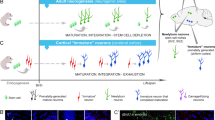Abstract
Effects of betaine on glutamate-induced neurotoxicity were examined on primary cultures of chicken embryonic brain cells and on rat cortical cultures. Betaine was found to attenuate glutamate-induced neurotoxicity both morphologically and biochemically. A 30 min exposure of chicken embryonic brain cells cultured for 12 days to 500 μM glutamate produced wide-spread acute neuronal swelling and neuritic fragmentation. A 2-h pretreatment of cultured chicken embryonic brain cells with 1 mM betaine prior to a 30 min exposure to 500 μM glutamate significantly raised the survival rate of neurons in the culture. When chicken embryonic brain cells were pretreated for 2 h with 1 mM betaine followed by exposure to 100 μM glutamate for 42 h, lactate dehydrogenase levels within the cells remained at 63% of untreated control values while glutamate-treated controls fell to 0% lactate dehydrogenase. Betaine also exerted attenuating effects on N-methyl-D-aspartate-, kainate- and quisqualate-induced neurotoxicity in a similar manner to that observed with glutamate. Similar neuroprotective effects of betaine were obtained with rat cortical cultures.
Similar content being viewed by others
References Cited
Choi, D. W. and Koh, J. Y., Quantitative determination of glutamate mediated cortical neuronal injury in cell culture by lactate dehydrogenase efflux assay.J. Neurosci. Methods, 20, 83–90 (1987).
Coutinho-Netto, J., Abdul-Ghani, A. S., Collins, J. F. and Bradford, H. F., Is glutamate a trigger factor in epileptic hyperactivity?.Epilepsia, 22, 289–296 (1981).
Dingledine, R., McBain, C. J. and McNamara, J. O., Excitatory amino acid receptors in epilepsy.TiPS, 11, 334–338 (1990).
Garthwaite, G. and Garthwaite, J., In vitro neurotoxicity of excitatory acid analogues during cerebellar development.Neuroscience, 17, 755–767 (1986).
Geddes, J. W., Chang-Chui, H., Cooper, S. M., Lott, I. T. and Cotman, C. W., Density and distribution of NMDA receptor in the human hippocampus in Alzheimer's disease.Brain Res., 399, 156–161 (1986).
Koh, J. Y. and Choi, D. W., Vulnerability of cultured cortical neurons to damage by excitotoxins; Differential susceptibility of neurons containing NADPH-diaphorase.J. Neurosci., 8, 2153–2163 (1988).
Loscher, W., Influence of pharmacological manipulation of inhibitory and excitatory neurotransmitter systems in seizure behavior in the mongolian gerbil.Pharmacol. Exp. Ther., 233, 204–213 (1984).
MacDermott, A. M., Mayer, M. L., Westbrook, G. L., Smith, S. J. and Barker, J. L., NMDA-receptor activation increases cytoplasmic calcium concentration in cultured spinal cord neurons.Nature, 321, 519–522 (1986).
Mamedov, M. D., Hayashi, H., Wada, H., Mohanty, P. S., Papageorgiou, G. C. and Murata, N., Glycinebetaine enhances and stabilizes the evolution of oxygen and the synthesis of ATP by cyanobacterial thylakoid membranes.FEBS Letters, 294, 271–274 (1991).
Maragos, W. F., Greenamyre, J. T., Penny, J. B. and Young, A. B., Glutamate dysfunction in Alzheimer's disease.Trends Neurosci., 10, 65–68 (1987).
Markelonis, G., Oh, T. H. and Derr, D., Stimulation of protein systhesis in cultured skeletal muscle by a trophic protein from sciatic nerves.Exp. Neurol., 60, 598–602 (1980).
Marthi, B. and Lighthart, B., Effects of betaine on enumeration of airbone bacteria.Appl. Environ, Microbiol., 56, 1286–1289 (1990).
Miyamoto, M., Murphy, T. H., Schnaar, R. L. and Coyle, J. T., Antioxidants protect against glutamate-induced cytotoxicity in a neuronal cell line.J. Pharm. Exp. Ther., 250, 1132–1140 (1989).
Monaghan, D. T., Bridges, R. J. and Cotman, C. W., The excitatory amino acid receptors: Their classes, pharmacology and distinct properties in the function of the central nervous system.Ann. Rev. Pharmacol. Toxicol., 29, 365–402 (1989).
Rossor, M. N., Neurotransmitter and CNS disease.Lancet, 27, 1200 (1982).
Rothman, S. M. and Olney, J. W., Glutamate and the pathophysiology of hypoxia-ischemic brain damage.Ann. Neurol., 19, 105–111 (1986).
Sensenbrenner, M., Springer, N., Booher, J. and Mandel, P., Histochemical studies during the differentiation of dissociated nerve cells cultivated in the presence of brain extracts.Neurobiol., 2, 49–55 (1972).
Simon, R. P., Swan, J. H., Griffiths, T. and Meldrum, B. S., Blockade of N-methyl-D-aspartate receptors may protect against ischemia damage in the brain.Science, 226, 850–852 (1984).
Smith, L. T., Smith, G. M. and Madkour, M. A., Osmoregulation in Agrobacterium tumefaciens: Accumulation of a Novel Disaccharide is controlled by Osmotic strength and glycine betaine.J. Bacteriol., 172, 6849–6855 (1990).
Young, A. B., Greenamyer, J. T., Hollingsworth, J., Albin, R., D'Amato, C. Shoulson, I and Penney, J. B., NMDA receptors losses in putamen from patients with Huntington's disease.Science, 241, 981–983 (1988).
Uckele, J. E., McDonald, J. W., Johnston, M. V. and Silverstein, F. S.Neurosci. Lett., 107, 279–283 (1989).
Author information
Authors and Affiliations
Rights and permissions
About this article
Cite this article
Park, M.J., Kim, S.R., Huh, H. et al. Betaine attenuates glutamate-induced neurotoxicity in primary cultured brain cells. Arch. Pharm. Res. 17, 343–347 (1994). https://doi.org/10.1007/BF02974174
Received:
Issue Date:
DOI: https://doi.org/10.1007/BF02974174




